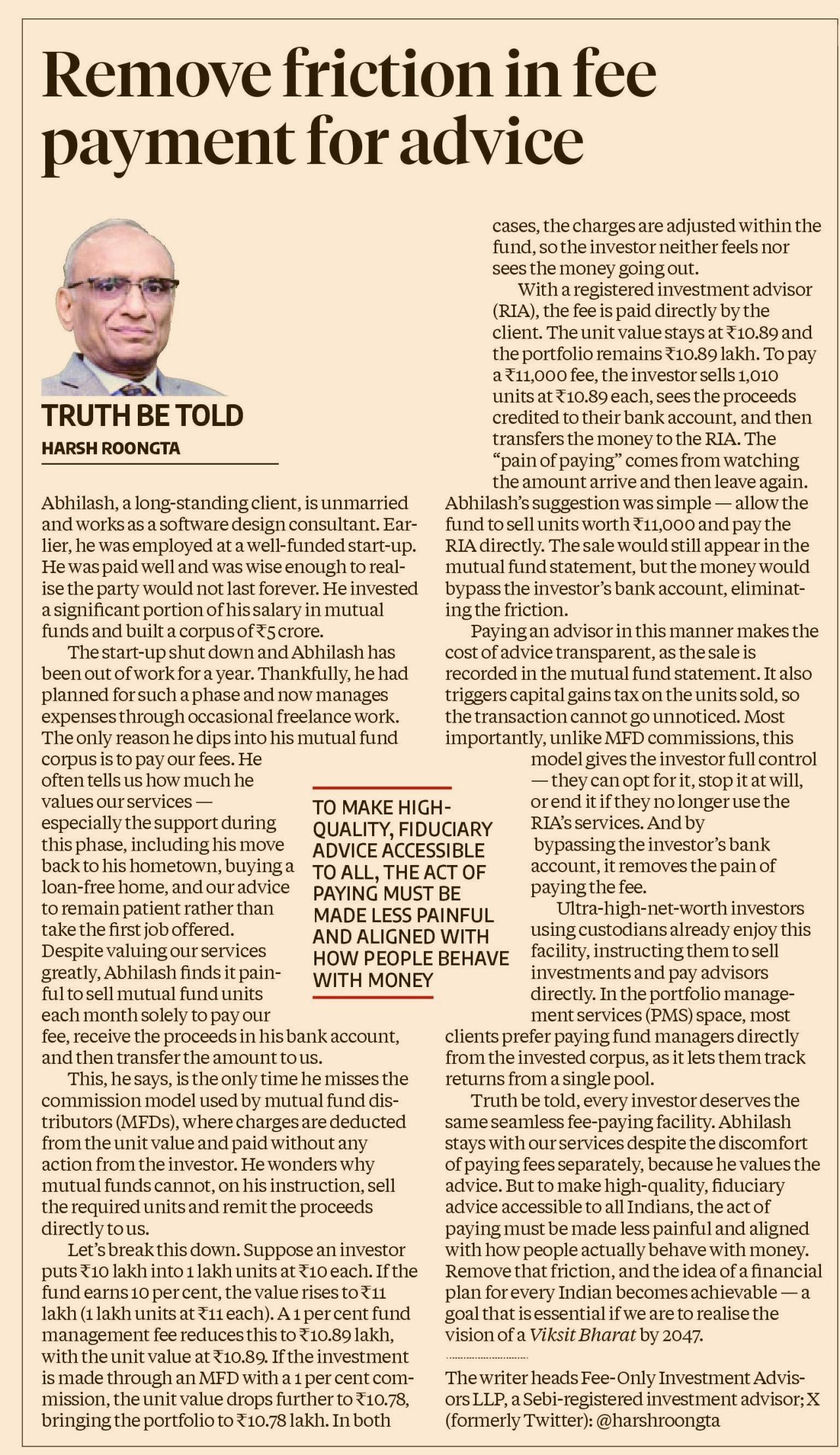
Abhilash, along-standing client, is unmarried and works as a software design consultant.
Earlier, he was employed at a well-funded start-up. He was paid well and was wise enough to realise the party would not last forever. He invested a significant portion of his salary in mutual funds and built a corpus of ₹ 5 crore. The start-up shut down and Abhilash has been out of work for a year. Thankfully, he had planned for such a phase and now manages expenses through occasional freelance work.
The only reason he dips into his mutual fund corpus is to pay our fees. He often tells us how much he values our services especially the support during this phase, including his move back to his hometown, buying a loan-free home, and our advice to remain patient rather than take the first job offered. Despite valuing our services greatly, Abhilash finds it painful to sell mutual fund units each month solely to pay our fee, receive the proceeds in his bank account, and then transfer the amount to us.
This, he says, is the only time he misses the commission model used by mutual fund distributors (MFDs), where charges are deducted from the unit value and paid without any action from the investor. He wonders why mutual funds cannot, on his instruction, sell the required units and remit the proceeds directly to us. Lets break this down. Suppose an investor puts ₹ 10 lakh into 1 lakh units at ₹ 10 each. If the fund earns 10 per cent, the value rises to ₹ 11 lakh (1 lakh units at ₹ 11 each).
A 1 per cent fund management fee reduces this to ₹ 10.89 lakh, with the unit value at ₹ 10.89. If the investment is made through an MFD with a 1 per cent commission, the unit value drops further to ₹ 10.78, bringing the portfolio to ₹ 10.78 lakh. In both cases, the charges are adjusted within the fund, so the investor neither feels nor sees the money going out. With a registered investment advisor (RIA), the fee is paid directly by the client.
The unit value stays at ₹ 10.89 and the portfolio remains ₹ 10.89 lakh. To pay a ₹ 11,000 fee, the investor sells 1,010 units at ₹ 10.89 each, sees the proceeds credited to their bank account, and then transfers the money to the RIA. The pain of paying comes from watching the amount arrive and then leave again.
Abhilash’s suggestion was simple allow the fund to sell units worth ₹ 11,000 and pay the RIA directly. The sale would still appear in the mutual fund statement, but the money would bypass the investors bank account, eliminating the friction. Paying an advisor in this manner makes the cost of advice transparent, as the sale is recorded in the mutual fund statement.
It also triggers capital gains tax on the units sold, so the transaction cannot go unnoticed. Most importantly, unlike MFD commissions, this model gives the investor full control they can opt for it, stop it at will, or end it if they no longer use the RIAs services. And by bypassing the investors bank account, it removes the pain of paying the fee. Ultra-high-net-worth investors using custodians already enjoy this facility, instructing them to sell investments and pay advisors directly.
In the portfolio management services (PMS) space, most clients prefer paying fund managers directly from the invested corpus, as it lets them track returns from a single pool. Truth be told, every investor deserves the same seamless fee-paying facility.
Abhilash stays with our services despite the discomfort of paying fees separately, because he values the advice. But to make high-quality, fiduciary advice accessible to all Indians, the act of paying must be made less painful and aligned with how people actually behave with money.
Remove that friction, and the idea of a financial plan for every Indian becomes achievable a goal that is essential if we are to realise the vision of aViksit Bharat by 2047.
The writer heads Fee-Only Investment Advisors LLP, a Sebi-registered investment advisor; X (formerly Twitter): @harshroongta to make high quality, fiduciary advice accessible to all, the act of paying must be made less painful and aligned with how people behave with money
TRUTH BE TOLD harsh roongta
Disclaimer: These are personal views of the writer. They do not necessarily reflect the opinion of www.business-standard.com or the Business Standard newspaper
(A slightly different version of this column first appeared in the Business Standard on August 11, 2025)
